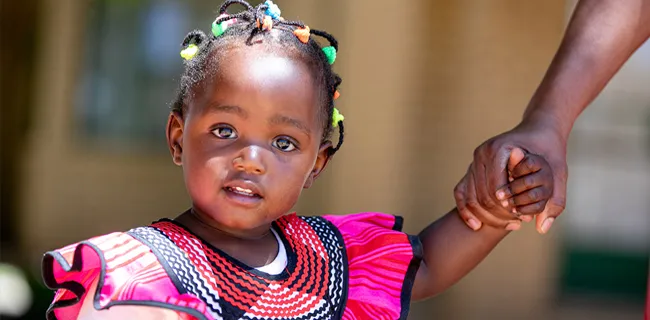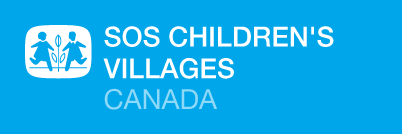1 in 3 Namibian children urgently need support amid ongoing drought and rising poverty

Tucked between the Atlantic Ocean and the Kalahari Desert, Namibia is a country in southern Africa with a population of 3 million people. Despite its natural resources, over 40% of Namibians live below the poverty line. Repeated droughts since 2019, beginning with the worst in a century, have pushed the country into a prolonged food crisis, leaving nearly half the population food insecure. As of March 2025, more than 376,000 children are without parental care or at risk of losing it – a sharp increase from 1 in every 5 Namibian children to now 1 in every 3.
Emilia Nambahu, a passionate child rights advocate from Namibia and member of the Board of Directors for SOS Children’s Villages Namibia and Canada, shared her insights on the challenges facing children across the country, and how Canadian donors are making a lasting difference.
A harsh reality for many children in Namibia
The daily struggles for many children are shaped by limited access to care, education and protection. Namibia, one of the most unequal countries in the world, continues to face serious challenges.
According to UNICEF, more than half of all Namibian children live in multidimensional poverty, lacking access to education, healthcare, adequate housing or the family income to meet basic needs.
Despite progress in legal protections, violence against children remains widespread. National data shows that two in five girls experience physical, emotional or sexual violence before the age of 18. Community-based child protection systems remain weak in many areas, making prevention and early intervention more difficult.
- Prolonged droughts and environmental degradation, worsened by climate change, have further deepened food insecurity and disrupted livelihoods, leaving families under greater strain and children at even greater risk.
“Gender-based violence, widespread poverty and neglect are part of a larger web of social challenges that threaten the wellbeing and survival of children.”
Education is out of reach for many children
While education is technically free in Namibia, the hidden costs make it inaccessible to many families.
“There are additional fees for school supplies, textbooks, uniforms, and transportation. For families living in multidimensional poverty, even basic access to education can feel impossible.”
SOS Children’s Villages affirms that education is a fundamental right and a crucial pillar of quality care and child development. All children and young people must have equitable access to inclusive, safe, and quality education, from early childhood through adolescence and into vocational training or higher education.
Education remains a significant barrier to opportunity in Namibia, especially beyond primary school. Only 60% of adolescents attend lower secondary school, less than 1 in 4 attend upper secondary school, and even fewer transition to vocational training or higher education.
Girls face additional challenges. Without access to sanitary products or safe transportation, and with the burden of household responsibilities, many girls miss school or drop out entirely. Early pregnancy and early or forced marriage create additional barriers to education.
Children in underserved rural and remote areas see even lower attendance. With secondary schools often far from home, poor infrastructure and limited financial resources can expose them to greater risks, pulling them further away from educational opportunities.
- Children without stable parental care or experiencing food insecurity are more likely to fall behind or leave school early.
“When you’re just trying to survive the day, school becomes a dream instead of a given.”
For Theresa*, starting school at age 10 was overwhelming – she couldn’t read or write and faced constant ridicule. With encouragement from a caring SOS mother and dedicated support from teachers, she caught up, persevered, and graduated top of her class with a diploma in electrical installation. “I want to study further to become an engineer.” Read more of Theresa’s story.
SOS Children’s Villages Namibia
Despite immense challenges, SOS Children’s Villages Namibia is offering real hope. Protection is at the core of every intervention, ensuring that children grow up in safe environments, free from violence, exploitation, and neglect. Through a dual approach of alternative care and family strengthening, they help children grow up with the security, support, and sense of belonging they need to thrive.
In alternative care settings, children receive:
- A safe, nurturing home environment, with an SOS mother and siblings;
- Access to education, including school materials, transportation, and uniforms;
- Access to healthcare and psychosocial support;
- Connection and care from trained, trusted caregivers and other dedicated professionals;
- Life skills, mentorship, and transitional support for older youth preparing for independent living; and
- An individualized development plan that supports their specific needs, personal goals and overall wellbeing.
Much of the lasting impact is being achieved through the Family and Community Strengthening Programs, keeping families together and reducing the need for alternative care.
- SOS Children’s Villages identifies the most vulnerable families through rigorous assessments, then offers tailored support, everything from economic empowerment to parenting workshops.
- These initiatives are especially vital in a country where droughts continue to strain livelihoods.
- This approach helps prevent family breakdown, and for many of the children who enter SOS Children’s Villages’ care, it creates the conditions for safe family reunification.
“We train mothers to become self-sufficient, so they can care for their children, earn a livelihood and rebuild their lives with dignity.”
For Keulukuwa, becoming a mother meant leaving school and struggling to meet her child’s needs. But everything changed when she received educational support and childcare assistance. Today, she balances motherhood with a thriving career, inspiring young mothers in her community to believe in their own potential. Read more of Keulukuwa’s story.
The resource gap and the importance of Canadian donors
“We have the professionals. We have the programs. What we don’t have are the financial resources. Without the support of our donors in Canada, we couldn’t do this work.”
Today, SOS Children’s Villages Namibia is primarily funded through the generosity of Canadian supporters.
“This support is not just appreciated, it’s essential. It’s keeping children safe. It’s keeping families together. It’s giving hope to an entire generation.”
A message to Canadian donors and partners
As a representative for SOS Children’s Villages Namibia, Emilia leaves us with a heartfelt message:
“I deeply appreciate the support we receive from Canada. Your investment is making a significant impact. It is helping us lower the vulnerability rate for children in Namibia. Through your support, we can strengthen families, provide education, offer healthcare, and reunite children with their loved ones. The problems are not all solved, but your partnership is helping us build long-term, sustainable solutions. Thank you for believing in our children, and for helping them believe in themselves.”
Why your support matters
Your support helps turn dreams into real opportunities for Namibian children, families, and the communities they belong to.
